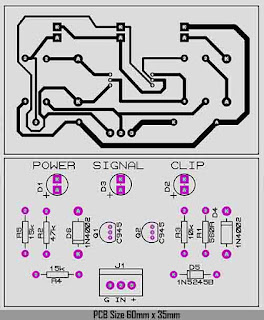

For example, A head unit with a maximum volume level of 40, theoretically, should be set no higher than 32 to avoid clipping the audio signal. An unofficial “rule of thumb” for finding the clipping point of a head unit is to calculate around 80% of the head unit’s maximum volume. In my explanations, I am assuming this action has been performed beforehand.
CLIPPING DETECTOR AMPLIFIER HOW TO
I will not be covering how to do this in this post. This can be accomplished in a similar fashion of setting the gain of the amplifier. NOTE: Before setting your amplifier gains, please make sure that you find the clipping point of your head unit.

A multi-channel amplifier will be similar, but you will use a 1KHz test tone instead of the 40 Hz tone. We will be discussing the steps needed to set the gain on a subwoofer amplifier. In this section, we will cover two proper ways to set the gain on your amplifier so that you will achieve the best possible sound quality, get loud, and nearly eliminate the potential of damaging any components. Some are not really recommended but can get you fairly close to an optimal setting. There are several methods to set the gain on an amplifier. This is where setting the gain adjustment is critical to match the head unit voltage to the amplifier.

The head unit with the 5V output would be significantly louder than the head unit with the 5.0V Now, if you played both at 100% volume, the 0.5V output head unit’s audio signal would be fairly loud, while the 5V output head unit would have, more than likely, damaged the speakers or even the amplifier itself. If they are connected, one at a time, to the same amplifier and the volume turned up to around 50%, you can hear the loudness difference between the 0.5V output and the 5V output. One of those head unit’s preamp output voltage measures 0.5V and the other measures around 5V. Think of it this way, if you have two head units that have a maximum volume of, let’s say, 35. Not only does this make your music sound like trash, but you can also potentially damage your speakers or subwoofers. By randomly turning the gain up, you are introducing distortion into the output signal of the amplifier. But, this does not mean the gain knob is a volume adjustment. If you are listening to music and you turn the gain adjustment up, you will notice that the volume of the music will also increase. So what is the gain adjustment? The gain adjustment is used to match the head unit’s output voltage to the amplifier so that the signal remains “clean” and is not distorting or clipping. In this post, I will discuss what the gain is and some different ways to adjust it to help prevent speaker damage while giving you the best possible audio. The main reason? To boost the overall output of your system so that you can get LOUD! The question is, how do you get loud without causing damage to your speakers? The answer is setting your gains properly. Under these coniditions it makes sense to me that a clipped signal into a woofer would be more damaging than a non clipped signal of the same average power.As discussed in my post “ Amplifiers: A Beginner’s Guide,” I discussed the benefits of installing an aftermarket amplifier in your vehicle. The woofer is doing no mechanical work and all energy is lost as heat. But this neglets that the woofer essentially stops at these peaks and we have no idea what kind of cooling is taking place.

I agree that you could argue the square wave as simply having double the power and that the woofer would remain unruined if it were rated to handle that thermal load.
CLIPPING DETECTOR AMPLIFIER FULL
He also fails to remember that these harmonics are riding at the top of a full power wave. As the author notes the harmonics as a source of movement of the woofer, he fails to mention that the sum of the harmonics look just like the waveform, which is the motion the woofer follows. In a subwoofer system it is not these signals are not harmful to the woofer. In fact when the second author from your first post talks about this indirectly when he speaks of harmonics riding the top of what appears to be a square wave. Ya the high frequency harmonics are the primary danger in a clipped signal. Re: Amp wattage greater than speaker rating


 0 kommentar(er)
0 kommentar(er)
